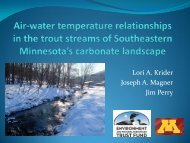Minnesota Water Resources Conference - Water Resources Center ...
Minnesota Water Resources Conference - Water Resources Center ...
Minnesota Water Resources Conference - Water Resources Center ...
Create successful ePaper yourself
Turn your PDF publications into a flip-book with our unique Google optimized e-Paper software.
BOOK OF ABSTRACTS<br />
Tuesday, Monday, October 27 23<br />
Concurrent Sessions I 10:00–11:30<br />
Track B: Managing <strong>Water</strong> Quantity and Quality in the <strong>Minnesota</strong> River Basin<br />
Rush River Hydrologic Study and <strong>Water</strong>shed Assessment Project<br />
Bob Barth, Bonestroo, bob.barth@bonestroo.com; Emily Resseger, Bonestroo<br />
Recently, there has been heightened interest in the hydrologic and water quality impacts of intensive<br />
agricultural land use in the <strong>Minnesota</strong> River basin. Increased agricultural production is made possible by<br />
draining wetlands and historic lakes. However, these drainage systems contribute to degraded water quality<br />
and increased bank erosion in the <strong>Minnesota</strong> River and its tributaries. Specifically, increased hydrologic<br />
variability leads to more flooding, causing bridge washouts, sedimentation, changes in stream alignment, and<br />
greater nutrient transport.<br />
As part of a larger Clean <strong>Water</strong> Partnership project, a hydrologic study of the approximately 400 square mile<br />
Rush River watershed focused on surface and tile drainage processes to identify opportunities for volume<br />
reduction. A detailed hydrologic and hydraulic XP-SWMM model of the Rush River watershed was calibrated to<br />
monitored flow rates collected near the mouth of each of the Rush River’s four main tributaries and in the River<br />
itself prior to joining the <strong>Minnesota</strong> River.<br />
The model identified and assessed potential storage areas and their ability to reduce flow in the Rush River.<br />
One of the most compelling findings of this study was how subsurface tile drainage affected the timing and<br />
magnitude of outflow hydrographs. By characterizing the surface hydrograph separate from the hydrograph of<br />
subsurface tile drainage, the total basin hydrograph closely matched the monitored flows. The study concluded<br />
that a comprehensive program to restore key lakes and wetlands throughout the watershed is required in order<br />
to provide adequate storage and reduce peak flows to more sustainable levels.<br />
Evaluating Different Strategies for Reducing Nonpoint Source Pollution in Seven Mile Creek <strong>Water</strong>shed<br />
Brent Dalzell, University of <strong>Minnesota</strong>, bdalzell@umn.edu; David Mulla, University of <strong>Minnesota</strong><br />
<strong>Water</strong> quality models are routinely applied to assess the feasibility of alternative management practices or<br />
land use scenarios for the purpose of achieving improvements for stream water quality. One shortcoming of<br />
this approach is that alternative scenarios are often applied to the watershed in a uniform manner and the<br />
relative sensitivity of different portions of the landscape is not taken into consideration. In this study, we<br />
evaluate different land cover and land management scenarios in Seven Mile Creek watershed, a predominatelyagricultural<br />
watershed located in the <strong>Minnesota</strong> River Basin. A suite of alternative management scenarios was<br />
developed based on historic land cover data (e.g., location of pre-settlement wetlands) as well as topographic<br />
characteristics. Further, we assess how decisions about identifying sensitive landscape components are<br />
influenced by input data by comparing results obtained from digital elevation models of varying resolution. The<br />
performance (and shortcomings) of different approaches for designing alternative management scenarios will<br />
be presented.<br />
19 <strong>Minnesota</strong> <strong>Water</strong> <strong>Resources</strong> <strong>Conference</strong>, October 27–28, 2008
















